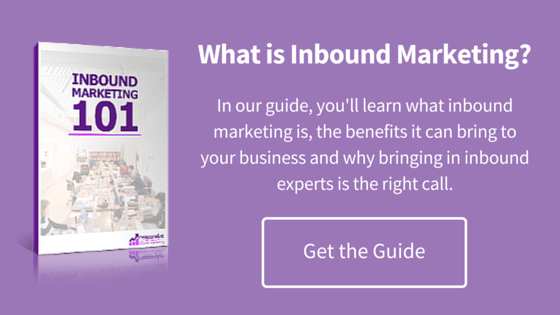Today's sales process looks different than it did a few years ago. Thanks to rapid advances in digital tech, buyers are doing advanced research and can enter a sales conversation already well informed. This impacts your company’s operating sales team.
 “Inbound sales transforms selling to match today’s empowered buyer -- so sales reps can sell the way people buy,” writes Mark Roberge for HubSpot. In this new sales environment, here are pro tips to help you not only meet, but crush your sales goals.
“Inbound sales transforms selling to match today’s empowered buyer -- so sales reps can sell the way people buy,” writes Mark Roberge for HubSpot. In this new sales environment, here are pro tips to help you not only meet, but crush your sales goals.
1. Start With Clear Goals
You need to know where you’re going before you can take steps to get there. Setting sales goals isn’t enough. You need to set SMART goals - Specific, Measurable, Attainable, Realistic and Time-bound. Clearly defined and concrete, SMART goals will help you develop a plan and usher your way to actually achieve them.
[DOWNLOAD]

Making a certain number of sales shouldn’t be your only target. You’ll also want to set activity based goals, such as number of leads contacted in a time period, product demos scheduled, number of follow-up calls made, etc. Breaking your main goal up into smaller pieces will give you little victories along the way, so instead of just staring at a mountain with no idea how to climb it, you’ll have a map guiding you to the top.
“Break your main goal into smaller pieces like leads contacted and demos scheduled,” says @RspnsvInbndMktg. Click To Tweet
2. Evaluate Your Progress
Set aside time each week to review how you’re progressing towards your goals. When you set big sales goals for yourself, it can be easy to lose sight of the big picture. Remember to check back on what you’re trying to achieve, what challenges you’re currently facing, and get help on how to overcome them. Evaluating your progress will help you to keep moving forward.
Research shows that people who write down their goals are at least 33% more likely to achieve them than people who only think about their goals, so get them down on paper and refer back to them often.
3. Define The Buyer’s Journey
The internet has changed the way we do business and how customers purchase. Forrester predicts that by 2020, 80% of the buying process will occur without any direct human-to-human interaction. Think about what your customers’ needs are during the stages of awareness, consideration and decision. Once you’ve clearly defined the buyer’s journey, you can build your sales process around it, which is also an opportunity to increase sales productivity.
Focus on the needs of your potential buyers, and how you can help to guide them through the remainder of their journey into becoming a customer. No one wants to feel like they are just another number on your list trying to be checked off. It can’t be all about you, and all about the sale.
4. Cold Calling Is Dead?
What used to be a hot ticket to sales, cold calling is now antiquated for the digital age. Since your sales process is based on the buyer’s journey, you’ll be able to tell if you have a sales-qualified lead before you pick up the phone.
When you do contact a lead, however, make sure you know who the person is on the other side of the phone, or computer screen; check your CRM and research online to get personal details, and keep a history of interactions with your company. Remember, you can’t share the same generic pitch to everyone. Segmenting your leads will also allow you to provide a more personalized experience.
“When your sales reps aren’t knowledgeable about your prospective buyers, there’s little else other than price for them to rely on to get a conversion. But when you understand your key targets—everything from their pain points to their past purchasing behaviors—you can lead with a value-first sales strategy,” writes D&B Hoovers.
Don’t waste time and energy trying to sell to everyone. Some people just won't be a fit for your business, and that’s okay.
5. Solve A Problem
Just having a cool product or service isn’t going to cut it. When you know who your leads are, you can better identify their pain points and problems. Your company should be addressing this through your content throughout the buyer’s journey. You have to add value first by providing relevant, educational and helpful content long before you even try to convert a lead. When you do contact a lead, show them how they can benefit from your product and what the outcome will be for them. When you show a lead how you can solve their problem, you’ll be well on your way to meeting your sales objectives.
6. Ditch The Script
People are more likely to buy from people they trust, and if you sound like a used-car salesman that just wants to make the sale, you’re lead is going to run away. When you’re talking with people, you can’t predict exactly how a conversation will go. However, this doesn’t mean that you shouldn’t come prepared. When you understand their common questions by doing your research on the person with whom you’ll be speaking, then you can better address them and respond to any reservations. It’s all about adding value.
Don’t underestimate the power of listening during a sales conversation, either. Actively listen and respond accordingly to what your lead says, and you’ll have a more productive conversation.
7. Collaborate With Marketing
When sales and marketing are aligned to meet the common goals of converting more customers and creating a positive customer experience, everybody wins. Businesses with effective sales and marketing alignment achieved 208% higher marketing revenue than organizations with disjointed teams, according to HubSpot. Help your marketing team to learn more about your company’s buyer personas by sharing what you’ve learned about leads and customers. What questions do they have? What makes them hesitant to buy? What size company, job title, or industry do they come from? Being collaborative will allow marketing to produce better content and messaging to reach your ideal customers, and send more qualified leads to sales.
As an organization, you should also be setting goals that support both marketing and sales so that everyone is working towards the same outcome.
